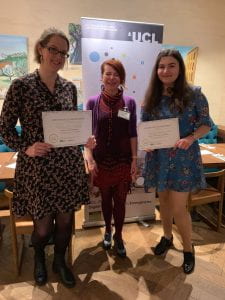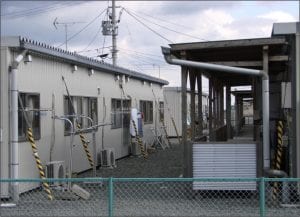9th International Conference on Digital Public Health
By Saqar ' M Al Zaabi, on 27 February 2020
The team from UCL IRDR Centre for Digital Public Health in Emergencies (dPHE) attended the 9th International Conference on Digital Public Health (www.acm-digitalhealth.org) chaired again by the dPHE Centre Director, Prof Patty Kostkova.
 Held on 20th – 23rd November 2019 in Marseille, France, the DPH 2019 was supported by the newly established UCL IRDR Centre for Digital Public Health in Emergencies (dPHE) and for the first time held in conjunction with a public health event – 12th European Public Health Conference 2019 and continue our cooperation with ACM Special Interest Group on Knowledge Discovery and Data Mining (SIGKDD). There were two parallel tracks on digital health: 9th DPH 2019 conference with technical focus, and a joint track with EPH ‘Digital Applications in Health’ bringing public health applications of digital health. Young researchers, MSc and PhD students enjoyed a truly interdisciplinary ‘Young Researches Forum’ day organised in collaboration with ASPHER, the Association of Public Health Schools in the European Region.
Held on 20th – 23rd November 2019 in Marseille, France, the DPH 2019 was supported by the newly established UCL IRDR Centre for Digital Public Health in Emergencies (dPHE) and for the first time held in conjunction with a public health event – 12th European Public Health Conference 2019 and continue our cooperation with ACM Special Interest Group on Knowledge Discovery and Data Mining (SIGKDD). There were two parallel tracks on digital health: 9th DPH 2019 conference with technical focus, and a joint track with EPH ‘Digital Applications in Health’ bringing public health applications of digital health. Young researchers, MSc and PhD students enjoyed a truly interdisciplinary ‘Young Researches Forum’ day organised in collaboration with ASPHER, the Association of Public Health Schools in the European Region.
Building on the growing success of previous editions (2008 London, 2009 Istanbul, 2010 Casablanca, 2011 Malaga, 2013 Rio de Janeiro, 2014 Soul, 2015 Florence, 2016 in Montreal, 2017 London, 2018 Lyon), the 9th International Digital Public Health conference mission has ideally met the EPH 2019 vision: ‘Building Bridges for Solidarity and Public Health’.
 This year, we enjoyed exciting plenary session bringing the highest calibre of international speakers for topical panel debates: ‘AI and Big Data: Ethical challenges and health opportunities’ (chaired by Patty, organised jointly with EPH), international perspective was discussed at a DPH plenary on ‘Challenges of Implementing Healthcare Technology and Innovation across Europe and Beyond’ (chaired by Dr Arnold Bosman) and lessons learned from successful DH innovation projects will be highlighted at plenary on ‘Digital Health Innovation: From Proof of Concept to Public Value’ (chaired by Dr Michael Edelstein). The role of fake news in social media for public health is addressed at the joint session: ‘Online anti-vaccination movements: The role of social media in public health communications’ was chaired by Patty and organised jointly by DPH, EUPHA Health promotion section & EUPHA Infection Diseases Control section. Another highlight featured the launch of the European mHealth Knowledge and Innovations Hub – a bold new partnership for the future of mHealth in WHO European Region. DPH 2019 offered even more: a joint EPH and RECON workshop offering a session on programming in R for epidemiologists.
This year, we enjoyed exciting plenary session bringing the highest calibre of international speakers for topical panel debates: ‘AI and Big Data: Ethical challenges and health opportunities’ (chaired by Patty, organised jointly with EPH), international perspective was discussed at a DPH plenary on ‘Challenges of Implementing Healthcare Technology and Innovation across Europe and Beyond’ (chaired by Dr Arnold Bosman) and lessons learned from successful DH innovation projects will be highlighted at plenary on ‘Digital Health Innovation: From Proof of Concept to Public Value’ (chaired by Dr Michael Edelstein). The role of fake news in social media for public health is addressed at the joint session: ‘Online anti-vaccination movements: The role of social media in public health communications’ was chaired by Patty and organised jointly by DPH, EUPHA Health promotion section & EUPHA Infection Diseases Control section. Another highlight featured the launch of the European mHealth Knowledge and Innovations Hub – a bold new partnership for the future of mHealth in WHO European Region. DPH 2019 offered even more: a joint EPH and RECON workshop offering a session on programming in R for epidemiologists.
In addition to being busy chairing with the event, Prof Patty Kostkova, Dr. Caroline Wood, Dr. Anwar Musah, Dr Adrian Rubio Solis and Georgiana Birjovanu had the opportunity to present their recent digital solutions to combat antibiotic overuse or to create an early-warning tool for the ZIKA virus and the gamified intervention improving resilience of women in Nepal, MANTRA. Several dPHE papers were published by ACM Digital Library and European Journal on Public Health.
The conference started with the Young Researchers Forum, where postgraduate students were able to present their recent work, followed by an exciting session on Missing Maps. This session, led by Katherine Roberts-Hill from the British Red Cross and Dr. Anwar Musah, and supported by Medicines Sans Frontiers, offered participants the opportunity to contribute to open-source maps that help geolocate women at risk of Female Genital Mutilation in Tanzania. A concurrent Missing Maps session was run at UCL for IRDR students by a guest lecturer at the Digital Heath module – real-time concurrent mapping in two countries – how more digital one can get? 😉
 The conference also comprised of many exciting sessions, from talks on how technology can help achieve a healthy lifestyle, assessing food consumption behaviour using machine learning in order to advise patients with diabetes to the potential of AI and Big data in the health domain.
The conference also comprised of many exciting sessions, from talks on how technology can help achieve a healthy lifestyle, assessing food consumption behaviour using machine learning in order to advise patients with diabetes to the potential of AI and Big data in the health domain.
One of the peak moments of this event was represented by the 2019 Innovation Prize Pitches, where the teams pitched for the Best Data-Driven Innovation and the Best Partnership awards. On behalf of UCL, Dr. Caroline Wood presented as the Best Partnership program the GADSA project, a Gamified Antimicrobial Decision Support App that provides feedback to surgeons when prescribing surgical antibiotic prophylaxis. Georgiana Birjovanu pitched for the Best Data-Driven Innovation, presenting the ZIKA platform and mobile app, designed to help health agents in Brazil to gather environmental data and to predict the mosquito populations based on the data collected. Both presentations were awarded the Best Runner Up awards by the international jury.
The Digital Public Health Conference represented a great opportunity to meet experts from different areas within the public health domain – world-class researchers, World Health Organization representatives and small to medium-sized enterprises – it’s where the digital health minds meet. No wonder #DPH2019 hashtag was trending on Twitter all week.
Please click the link below to watch a video of photos showing the different conference events.
https://drive.google.com/file/d/1UMQ8ExeLHE4NdPM69Q7AkUTZsWt4IbyV/view
We look forward to DPH 2020 and hope to tempt more IRDR colleagues to attend this exciting event with us 🙂
 Close
Close



